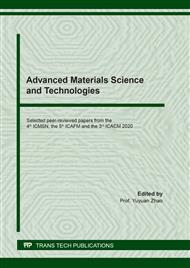[1]
Zhou Y., Nomura T. & Saitou K. (2019). Multicomponent topology optimization for additive manufacturing with build volume and cavity free constraints. J. Comput. Inf. Sci. Eng, 19(2).
DOI: 10.1115/1.4042640
Google Scholar
[2]
Xiong, Y., Yao, S., Zhao, Z.-L., & Xie, Y. M. (2020). A new approach to eliminating enclosed voids in topology optimization for additive manufacturing. Additive Manufacturing, 32.
DOI: 10.1016/j.addma.2019.101006
Google Scholar
[3]
Mhapsekar K., McConaha M. & Anand S. (2018). Additive manufacturing constraints in topology optimization for improved manufacturability. J. Manuf. Sci. Eng, 140(5).
DOI: 10.1115/1.4039198
Google Scholar
[4]
Wang W., Munro D., Wang C.C.L., van Keulen F. & Wu J. (2019). Space-time topology optimization for additive manufacturing: concurrent optimization of structural layout and fabrication sequence. Structural and Multidisciplinary Optimization, 61(1), 1–18.
DOI: 10.1007/s00158-019-02420-6
Google Scholar
[5]
Clausen A., Aage N. & Sigmund O. (2016). Exploiting additive manufacturing infill in topology optimization for improved buckling load. Engineering, 2(2), 250–257.
DOI: 10.1016/j.eng.2016.02.006
Google Scholar
[6]
Information on https://www.beamler.com/post-processing-3d-printing/.
Google Scholar
[7]
https://www.3dhubs.com/knowledge-base/supports-3d-printing-technology-overview/.
Google Scholar
[8]
https://www.protolabs.com/resources/design-tips/post-processing-for-metal-3d-printing/.
Google Scholar
[9]
Information on https://grabcad.com/challenges/ge-jet-engine-bracket-challenge.
Google Scholar
[10]
Ahmed W., Alabdouli H., Alqaydi H., Mansour A., Al K.H., Al J.H., & 10th Annual International IEOM Conference, (2020). Open source 3d printer: a case study. Proceedings of the International Conference on Industrial Engineering and Operations Management, March, 2995–3004.
Google Scholar
[11]
Mansour A., Alabdouli H., Alqaydi H., Al K.H., Ahmed W., Al J.H. & 10th Annual International IEOM Conference, (2020). Evaluating the 3d printing capabilities. Proceedings of the International Conference on Industrial Engineering and Operations Management, March, 2618–2629.
Google Scholar
[12]
Al Darmaki A., Al Shamsi A., Ahmed W.K., Al Jassmi H. & 2019 Advances in Science and Engineering Technology International Conferences (ASET) Dubai, United Arab Emirates, March (2019). In Designing and developing innovative structural engineering failure experiment using additive manufacturing technology (p.1–6).
DOI: 10.1109/icaset.2019.8714208
Google Scholar


